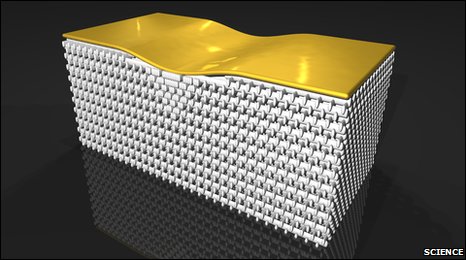3-D cloaking achieved for visible light
May 19, 2011
Karlsruhe Institute of Technology Center for Functional Nanostructures (CFN) researchers have created the first 3-D invisibility cloak for ordinary (non-polarized) visible light, limited at this time to the 700 nm. (red) range.
Cloaking was first developed, in 2006, for the microwave range, and has more recently been extended to the infrared (IR) range. In 2010, CFN researchers presented the first 3-D invisibility cloak in the journal Science, limited to infrared wavelengths. Previous devices were only able to hide objects from light traveling in only one direction; viewed from any other angle, the object would remain visible.

The nanostructure of tiny rods bends light around a bump in the gold surface in this first 3-D cloak (credit: Science)
How it works
An invisibility cloak is basically a simple magic trick, using a waveguide that guides incident light waves out of the cloak to make it appear that the light waves never actually came in contact with the object. The waveguide is made of metamaterials — materials with special optical properties created by using a photolithographic method called “direct laser writing,” in the case of CFN.
But the particles of the metamaterial have to be smaller than the wavelength of the light that is to be deflected — that’s the challenge. For the cloak to be invisible at wavelengths visible to human beings, the metamaterial particle size needs to be in the range of a 700 nanometers (for red light) or less.
If CFN can get the metamaterial particle dimensions down below 400 nm., invisibility in white light can be achieved. At that point, we are in the realm of Harry Potter’s invisibility cloak.
Practical applications of the research include flat, aberration-free lenses for use in integrated optical chips and optical “black holes” for concentrating and absorbing light in solar cells.
Ref.: J. Fischer, T. Ergin, and M. Wegener, Three-dimensional polarization-independent visible-frequency carpet invisibility cloak, Optics Letters (in press)
